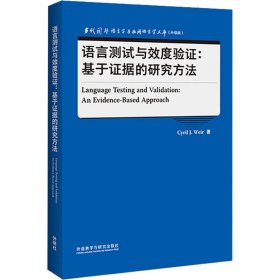
语言测试与效度验证:基于证据的研究方法
正版保障 假一赔十 可开发票
¥ 33.88 6.2折 ¥ 55 全新
仅1件
作者Cyril J. Weir著
出版社外语教学与研究出版社
ISBN9787521329742
出版时间2021-09
装帧平装
开本其他
定价55元
货号11311201
上书时间2024-12-01
- 最新上架
商品详情
- 品相描述:全新
- 商品描述
-
作者简介
西里尔·J. 韦尔(Cyril J. Weir):世界知名语言测试专家,曾任教于英国贝德福特大学,并担任英语学习与评估研究中心主任。他还曾在兰卡斯特大学、雷丁大学等大学任教。在上海交通大学任客座教授期间,指导过我国大学英语四、六级考试(CET)和英语专业四、八级考试(TEM)的设计开发和研究工作。
目录
General Editors Preface
Acknowledgements
Abbreviations
Introduction
Part I Testing as Validity
1 Language Testing Past and Present
1.1 The Cambridge Proficiency Examination 1913-1945: The Garden of Eden, the pre-scientific era
1.2 Developments in the 1960s: the move towards a language-based examination
1.3 The 1975 and 1984 revisions: The Promised Land?
2 The Nature of Test Validity
3 Before the Test Event: A Priori Validity Evidence
3.1 Theory-based validity
3.2 Context validity
4 After the Test Event: A Posteriori Validity Evidence
4.1 Scoring validity
4.2 Criterion-related validity
4.3 Consequential validity
Part 2 New Frameworks for Developing and Validating Tests of Reading, Listening, Speaking and Writing
Introduction
5 Test Takers
5.1 Physical/physiological characteristics: making accommodations
5.2 Psychological characteristics: affective schemata
5.3 Experiential characteristics: familiarity
6 Context Validity in Action
6.1 Task setting
6.2 Task demands
6.3 Setting and test administration
7 Theory-based Validity in Action
7.1 Reading
7.2 Listening
7.3 Speaking
7.4 Writing
8 Response Formats
8.1 Techniques for testing reading comprehension
8.2 Techniques for testing listening comprehension
8.3 Techniques for testing speaking
8.4 Techniques for testing written production
9 Scoring Validity in Action
9.1 Scoring written production
9.2 Scoring speaking tests
9.3 Internal reliability of receptive tests
9.4 Scores, grading and post-exam validation procedures
10 External Validities in Action
10.1 Criterion-related validity
10.2 Consequential validity
Part 3 Generating Validity Evidence
Introduction
11 Research Methodologies for Exploring the Validity of a Test
11.1 An introductory note on research
11.2 A priori validation: investigating the specification of the construct and the operationalization of the test
11.3 Establishing context validity
11.4 Establishing theory-based validity evidence
11.5 Establishing scoring validity evidence
11.6 Establishing evidence on a posteriori validities
Part 4 Further Resources in Language Testing
12 Key Sources
12.1 Books
12.2 Journals
12.3 Professional associations
12.4 Principal testing conferences
12.5 Email lists and bulletin boards
12.6 Internet sites
12.7 Databases
12.8 Statistical packages
Postscript
References
Index
精彩内容
本书是一部全面、系统地阐述语言测试效度的专著。本书吸收了效度研究的最新成果,提出了基于证据的效度验证的理论框架,并列举了大量研究实例。全书分为四个部分:效度理论,讲述语言测试的历史和现状,探讨测试效度的本质;听说读写测试效验的新框架,具体分析情景效度、基于理论的效度、测试方法、评分效度等;收集效度证据的方法;语言测试的资源。本书为对语言效度问题感兴趣的读者提供了很好的参考。
媒体评论
“当代国外语言学与应用语言学文库”(升级版)是主要面向高校英语专业高年级本科生、研究生及英语教师的一套大型、开放的系列丛书。本升级版或保留原有经典图书品种,或继之以经典图书的新版,或引进国外语言学与应用语言学领域的新锐力作以进一步拓展学科领域,希望它能继续对我国语言学教学与研究和外语教学与研究起到积极的推动作用。
《语言测试与效度验证:基于证据的研究方法》吸收了效度研究的成果,提出了基于证据的效度验证的理论框架,并列举了大量研究实例,堪称语言测试效度理论与实践的里程碑之作。本书是对语言效度问题感兴趣的读者不可错过的一本好书。
相关推荐
-

语言测试与效度验证:基于证据的研究方法
全新广州
¥ 34.16
-

语言测试与效度验证:基于证据的研究方法
全新广州
¥ 32.16
-

语言测试与效度验证:基于证据的研究方法
全新广州
¥ 32.16
-

语言测试与效度验证:基于证据的研究方法
全新广州
¥ 34.16
-

语言测试与效度验证:基于证据的研究方法
全新广州
¥ 34.16
-

语言测试与效度验证:基于证据的研究方法!
全新北京
¥ 36.60
-

语言测试与效度验证:基于证据的研究方法
全新南京
¥ 40.15
-

语言测试与效度验证:基于证据的研究方法!
全新北京
¥ 36.60
-

语言测试与效度验证:基于证据的研究方法
全新保定
¥ 39.68
-

语言测试与效度验证:基于证据的研究方法
全新东莞
¥ 35.04
— 没有更多了 —












以下为对购买帮助不大的评价